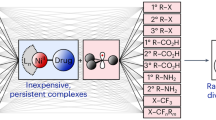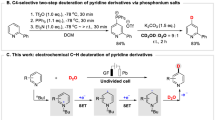Abstract
LYSINE and glyoxaline-4-5-dicarboxylic acid1 and histidine2 have been shown to activate preparations of Keilin horse-heart succinoxidase in unfavourable environments. A property common to these compounds is their ability to chelate heavy metals. We have accordingly tested the effect of other well-known chelating agents upon this system in bicarbonate buffer, which has been shown by Bonner2 to depress its activity. In Table 1 are shown typical results.
This is a preview of subscription content, access via your institution
Access options
Subscribe to this journal
Receive 51 print issues and online access
$199.00 per year
only $3.90 per issue
Buy this article
- Purchase on Springer Link
- Instant access to full article PDF
Prices may be subject to local taxes which are calculated during checkout
Similar content being viewed by others
References
Ball, E. G., and Cooper, F., J. Biol. Chem., 180, 113 (1949).
Bonner, W. D., Nature, 165, 757 (1950).
Slater, E. C., Biochem. J., 45, 1, 8, 14 (1949).
Judah, J., and Rees, K. R. (private communication, 1952).
Keilin, D., and Hartree, E. F., Biochem. J., 44, 205 (1949).
Horecker, B. L., Stotz, E., and Hogness, T. R., J. Biol. Chem., 128, 251 (1939).
Author information
Authors and Affiliations
Rights and permissions
About this article
Cite this article
ALTMANN, S., CROOK, E. Activation of Enzymes by Chelating Agents. Nature 171, 76–77 (1953). https://doi.org/10.1038/171076b0
Issue Date:
DOI: https://doi.org/10.1038/171076b0
This article is cited by
Comments
By submitting a comment you agree to abide by our Terms and Community Guidelines. If you find something abusive or that does not comply with our terms or guidelines please flag it as inappropriate.



